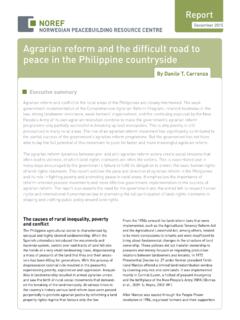Transcription of TRANSPORTATION REVOLUTION OF THE 19TH CENTURY
1 From ABC-CLIO's American History website REVOLUTION OF THE 19TH CENTURYIn America during the 19th CENTURY , the invention of the steam engine dramaticallyimproved shipping by water and created a new TRANSPORTATION industry the the end of the CENTURY , some steam locomotives began to be powered the time of America's founding, most people lived their entire lives in their localcommunities. Local TRANSPORTATION was by walking, riding a horse, or riding in awagon or carriage pulled by a horse. For distances of a few miles, freight also movedby wagons. Intercity freight was either carried in barges on inland rivers or in sailing ships on the TravelFor those rare occasions when they traveled longer distances, people still walked or used a horse, typicallytraveling no more than 20 or 30 miles per day.
2 Most roads were just wagon ruts, which limited wagons to aboutthe speed of a walker roughly three miles per hour. For food and lodging, travelers went to small inns, whichwere taverns with shared bedrooms that often slept three or more to a bed, including strangers. Traveling wasnot a pleasant were a few stagecoach lines between some major cities that traveled about 50 miles per day depending onthe quality of the roads, but they were expensive. There were also a few privately owned turnpikes (toll roads)around major Eastern cities, but they did not cover long only organized travel was by sailing ships that carried passengers and freightover planned routes on the Great Lakes, between cities on the East Coast, andbetween America and Europe. A one-way trip to Europe commonly took six to 10weeks, depending on winds and storms.
3 Shipwrecks were a common the rst activities Americans undertook after the country's founding were tobuild better turnpikes, faster sailing ships, and canals connecting rivers and investors started building bridges and paving roads with stones and gravel in 1793 near Philadelphia,Pennsylvania. As the turnpikes spread to major cities, stagecoach travel became much faster and safer, but theturnpikes were not pro table for investors, so road building became an activity for regional nanced toll roads still exist Ship DesignBecause of the long distances between coastal cities, American ship owners needed fast ships. Consequently,during the rst half of the 19th CENTURY , American ship designers created two new designs for sailing ships, theschooner and the clipper ship, which were faster than the square-rigged merchant ships and could carry areasonable load of cargo and passengers.
4 Schooners sailed better into the wind than the square-rigged ships, sothey were faster within America's coastal waters where maneuverability was ships, which were developed during the 1830s, were even faster, sometimes traveling up to 20 miles perhour compared to around 8 miles per hour for the typical merchant ship. During the California gold rush in theearly 1850s, clipper ships sailed between New York and San Francisco around the tip of South America in just overthree months, whereas the trip on a merchant ship took on average six inland rivers, problems of navigation often presented the greatest challenge. To improve shipping, canalswere built to move freight and sometimes passengers between rivers and lakes. Many canals employed horses ormules that pulled barges on tracks next to the waterway.
5 Most canals also require locks to raise and lower waterlevels and allow barges to move from one elevation to another. Both canals and locks proved expensive to build,meaning that many canals companies were heavily in debt during the rst several years of Erie CanalIn 1793, the rst canal was built to haul freight around shallow areas of theConnecticut River in Massachusetts. Canals were then built to make other Easternrivers easier to navigate. The most signi cant early canal was the Erie Canal inupstate New York connecting the Hudson River with Lake Erie, which opened in the Erie Canal, freight could move from ocean-going ships docked in New YorkCity to barges on the Hudson River, through the canal to Lake Erie, and then on tosettlements on the Great Lakes, reducing the travel time to Lake Erie from 20 days over land to 8 days on success of the Erie Canal led to a great burst of canal building in the country, including the Illinois Canal thatconnected Lake Michigan (and therefore New York through the Erie Canal) to the Mississippi River.
6 By the middleof the 19th CENTURY , Americans had built over 4,000 miles of canals. However, railroads eventually replaced thembecause freight moved faster by railroad than by the early 1800s, American inventors developed new concepts for providing power to machines, includingthose for TRANSPORTATION steam engines, which provided radical new approaches for moving people and goodswithin the country and around the world. Ships and railroads were the rst to gain from the new for the Industrial REVOLUTION and for TRANSPORTATION , the development of a practical steam engine was thepivotal invention of the 19th CENTURY . A steam engine boils water in a boiler heated by a rebox that burns coal,oil, or natural gas to produce steam, with coal the most common fuel. The steam is either injected into a piston orinto a turbine to produce power to move the rst commercially successful application of steam to power American ships was forinland river steamboats.
7 In 1807, using a steam engine he purchased in England, RobertFulton demonstrated his concept for a steam-driven riverboat on the Hudson River betweenNew York City and Albany, New York a distance of 130 miles. His steamboat proved animmediate success, so he built more boats and operated scheduled service on the 1811, Fulton demonstrated another steamboat running from Pittsburgh, Pennsylvania onthe Ohio River to New Orleans, Louisiana on the Mississippi River. It also was an immediatesuccess and launched a new era of steamboat travel. Soon, all of the navigable rivers inAmerica had and American RiversThe steamboat was the rst unique American invention to open up the Midwest and the Prairie States tosettlement. Wherever large rivers owed, towns grew into cities by o ering out tting equipment and wagontrains for the hordes of settlers going further west to establish a new life.
8 The cities were also collection points forshipping the products of the newly settled West back to the East. In particular, St. Louis and Kansas City, Missouriowe their early success to the in 1838, steam engines began powering ocean-going ships. Although earlier ships used steam engines asauxiliary power, the rst ocean-going ships to use steam exclusively were the British ships Sirius and the GreatWestern, which left England within a few days of each other and arrived in New York City in under 20 days. Bothships burned coal to make steam. Even though the two trial runs were impressive, steamships were slow toreplace sailing ships, partially because of the added expense of coal. Because of reliability problems, most earlysteamships still carried masts and sails just in steam power was rst applied to land TRANSPORTATION in England during 1825, a new form of travel wascreated the railroad.
9 Previous to this development, horses had pulled wagons on wooden rails in a fewAmerican cities. The rails o ered a smoother ride and more passengers for each horse than travel by wagons, butthe cost of building and maintaining the roadbeds and taking care of the horses was high. The country needed amechanical power source that could pull much larger loads at a lower cost, and a steam-driven locomotive metthat locomotives spread to America in 1830 when the South Carolina Canal and Railroad Company startedcommercial service over 6 miles of track. Also in 1830, the Baltimore and Ohio Railroad (B&O) started building arailroad to connect Baltimore, Maryland on the East Coast with the Ohio River in the Midwest. The B&O becamethe rst permanent railroad in the during the Civil WarFrom these two demonstrations, railroads spread rapidly throughout the easternpart of the country.
10 By the 1850s, most towns had railroad passenger and freightservice, and a few lines had spread west and reached the Mississippi River. Duringthe Civil War, railroads were crucial for both sides to supply their armies and movetroops, although the North enjoyed a tremendous advantage in this arena with farmore track available to aid the war e ort. Construction to repair track damage afterthe war ended modernized many of the railroads, giving them the means to the Civil War, Congress funded a project to build a transcontinental railroad by providing constructionfunds and a land grant of one square mile of land for each two miles of track that railroads built. The idea hadbeen batted around among legislators for years, but sectional disagreements as to whether the track should belaid on a Northern route or a Southern one delayed any signi cant progress on the project.








